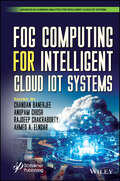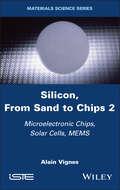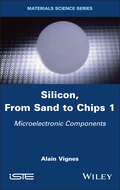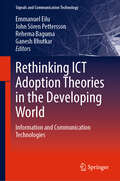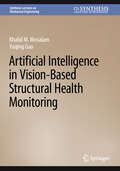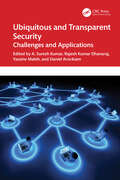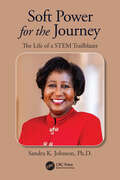- Table View
- List View
Intelligent Communication Networks: Research and Applications
by Siddhartha Bhattacharyya Avishek Nag Rajarshi MahapatraWith the advent of Big Data, conventional communication networks are often limited in their inability to handle complex and voluminous data and information as far as effective processing, transmission, and reception are concerned. This book discusses the evolution of computational intelligence techniques in handling intelligent communication networks. Provides a detailed theoretical foundation of machine learning and computational intelligence algorithms Highlights the state of art machine learning-based solutions for communication networks Presents video demonstrations and code snippets on each chapter for easy understanding of the concepts Discusses applications including resource allocation, spectrum management, channel estimation, and physical layer of wireless networks Demonstrates applications of machine learning techniques for optical networks The text is primarily intended for senior undergraduate and graduate students and academic researchers in fields of electrical engineering, electronics and communication engineering, and computer engineering.
Artificial Intelligence Enabled Signal Processing based Models for Neural Information Processing
The book provides details regarding the application of various signal processing and artificial intelligence-based methods for electroencephalography data analysis. It will help readers in understanding the use of electroencephalography signals for different neural information processing and cognitive neuroscience applications. The book: Covers topics related to the application of signal processing and machine learning-based techniques for the analysis and classification of electroencephalography signals Presents automated methods for detection of neurological disorders and other applications such as cognitive task recognition, and brain-computer interface Highlights the latest machine learning and deep learning methods for neural signal processing Discusses mathematical details for the signal processing and machine learning algorithms applied for electroencephalography data analysis Showcases the detection of dementia from electroencephalography signals using signal processing and machine learning-based techniques It is primarily written for senior undergraduates, graduate students, and researchers in the fields of electrical engineering, electronics and communications engineering, and biomedical engineering.
Artificial Intelligence Enabled Signal Processing based Models for Neural Information Processing
by Ram Bilas Pachori Rajesh Kumar TripathyThe book provides details regarding the application of various signal processing and artificial intelligence-based methods for electroencephalography data analysis. It will help readers in understanding the use of electroencephalography signals for different neural information processing and cognitive neuroscience applications. The book: Covers topics related to the application of signal processing and machine learning-based techniques for the analysis and classification of electroencephalography signals Presents automated methods for detection of neurological disorders and other applications such as cognitive task recognition, and brain-computer interface Highlights the latest machine learning and deep learning methods for neural signal processing Discusses mathematical details for the signal processing and machine learning algorithms applied for electroencephalography data analysis Showcases the detection of dementia from electroencephalography signals using signal processing and machine learning-based techniques It is primarily written for senior undergraduates, graduate students, and researchers in the fields of electrical engineering, electronics and communications engineering, and biomedical engineering.
Topics in Cryptology – CT-RSA 2024: Cryptographers’ Track at the RSA Conference 2024, San Francisco, CA, USA, May 6–9, 2024, Proceedings (Lecture Notes in Computer Science #14643)
by Elisabeth OswaldThis book constitutes the refereed proceedings of the Cryptographer's Track at the RSA Conference 2024, CT-RSA 2024, held in San Francisco, CA, USA, during May 6–9, 2024. The 18 full papers presented in this volume were carefully reviewed and selected from 46 submissions. The conference presents papers on subjects such as public key cryptography; symmetric cryptography; signatures; homomorphic encryption; identity-based encryption; constructions; and threshold signatures and fault attacks.
Software Engineering and Management: Volume 16 (Studies in Computational Intelligence #1137)
by Roger LeeThe book reports state of the art results in Software Engineering Research, Management & Applications in both printed and electronic form. SCI (Studies in Computation Intelligence) has grown into the most comprehensive computational intelligence research forum available in the world.This volume published original papers on both theory and practice that address foundations, state of the art problems and solutions, and crucial challenges.
Towards Ulam Type Multi Stability Analysis: A Novel Approach for Fuzzy Dynamical Systems (Studies in Systems, Decision and Control #523)
by Reza Saadati Tofigh Allahviranloo Safoura Rezaei Aderyani Chenkuan LiThe main target of this book is to present a new concept of Ulam-type stability, i.e., multi-stability, through the classical, well-known special functions and to obtain the best approximation error estimates by a different concept of perturbation stability including fuzzy approaches for uncertainty considerations. This stability allows us to obtain diverse approximations depending on various special functions that are initially chosen and to evaluate maximal stability and minimal error which enable us to obtain a unique optimal solution of functional equations, inequalities, and fractional equations. Stability analysis in the sense of the Ulam and its different kinds has received considerable attention from the researchers. However, how to effectively generalize the Ulam stability problems and to evaluate optimized controllability and stability are new issues. The multi-stability not only covers the previous concepts but also considers the optimization of the problem and provides a comprehensive discussion of optimizing the different types of the Ulam stabilities of mathematical models used in the natural sciences and engineering disciplines with fuzzy attitudes. Besides, this book also deals with nonlinear differential equations with various boundary conditions or initial value problems, based on the matrix Mittag-Leffler function, fixed point theory, as well as Babenko's approach to study uniqueness and existence of solutions. In general, the benefits for the readers can be concluded as follows: 1. Evaluates maximal stability with minimal error to get a unique optimal solution. 2. Discusses an optimal method of the alternative to study existence, uniqueness, and different types of Ulam stabilities under special consideration of the fuzzy approaches. 3. Delves into the new study of boundary value problems of fractional integro-differential equations with integral boundary conditions and variable coefficients.
Fog Computing for Intelligent Cloud IoT Systems (Advances in Learning Analytics for Intelligent Cloud-IoT Systems)
by Ahmed A. Elngar Rajdeep Chakraborty Anupam Ghosh Chandan BanerjeeFOG COMPUTING FOR INTELLIGENT CLOUD IOT SYSTEMS This book is a comprehensive guide on fog computing and how it facilitates computing, storage, and networking services Fog computing is a decentralized computing structure that connects data, devices, and the cloud. It is an extension of cloud computing and is an essential concept in IoT (Internet of Things), as it reduces the burden of processing in cloud computing. It brings intelligence and processing closer to where the data is created and transmitted to other sources. Fog computing has many benefits, such as reduced latency in processing data, better response time that helps the user’s experience, and security and privacy compliance that assures protecting the vital data in the cloud. It also reduces the cost of bandwidth, because the processing is achieved in the cloud, which reduces network bandwidth usage and increases efficiency as user devices share data in the local processing infrastructure rather than the cloud service. Fog computing has various applications across industries, such as agriculture and farming, the healthcare industry, smart cities, education, and entertainment. For example, in the agriculture industry, a very prominent example is the SWAMP project, which stands for Smart Water Management Platform. With fog computing’s help, SWAMP develops a precision-based smart irrigation system concept used in agriculture, minimizing water wastage. This book is divided into three sections. The first section studies fog computing and machine learning, covering fog computing architecture, application perspective, computational offloading in mobile cloud computing, intelligent Cloud-IoT systems, machine learning fundamentals, and data visualization. The second section focuses on applications and analytics, spanning various applications of fog computing, such as in healthcare, Industry 4.0, cancer cell detection systems, smart farming, and precision farming. This section also covers analytics in fog computing using big data and patient monitoring systems, and the emergence of fog computing concerning applications and potentialities in traditional and digital educational systems. Security aspects in fog computing through blockchain and IoT, and fine-grained access through attribute-based encryption for fog computing are also covered. Audience The book will be read by researchers and engineers in computer science, information technology, electronics, and communication specializing in machine learning, deep learning, the cyber world, IoT, and security systems.
Silicon, From Sand to Chips, Volume 2: Microelectronic Chips, Solar Cells, MEMS
by Alain VignesSilicon is the material of the digital revolution, of solar energy and of digital photography, which has revolutionized both astronomy and medical imaging. It is also the material of microelectromechanical systems (MEMS), indispensable components of smart objects. The discovery of the electronic and optoelectronic properties of germanium and silicon during the Second World War, followed by the invention of the transistor, ushered in the digital age. Although the first transistors were made from germanium, silicon eventually became the preferred material for these technologies. Silicon, From Sand to Chips 2 traces the history of the discoveries, inventions and developments in basic components and chips that these two materials enabled one after the other. The book is divided into two volumes and this second volume is devoted to microelectronic and optoelectronic chips, solar cells and MEMS.
Silicon, From Sand to Chips, Volume 1: Microelectronic Components
by Alain VignesSilicon is the material of the digital revolution, of solar energy and of digital photography, which has revolutionized both astronomy and medical imaging. It is also the material of microelectromechanical systems (MEMS), indispensable components of smart objects. The discovery of the electronic and optoelectronic properties of germanium and silicon during the Second World War, followed by the invention of the transistor, ushered in the digital age. Although the first transistors were made from germanium, silicon eventually became the preferred material for these technologies. Silicon, From Sand to Chips 1 traces the history of the discoveries, inventions and developments in basic components and chips that these two materials enabled one after the other. The book is divided into two volumes and this first volume is devoted to basic microelectronic components.
Digital Business and Electronic Commerce: Strategy, Business Models and Technology (Springer Texts in Business and Economics)
by Bernd W. WirtzThis textbook introduces readers to digital business from a management standpoint. It provides an overview of the foundations of digital business with basics, activities and success factors, and an analytical view on user behavior. Dedicated chapters on mobile and social media present fundamental aspects, discuss applications and address key success factors. The Internet of Things (IoT) is subsequently introduced in the context of big data, cloud computing and connecting technologies, with a focus on industry 4.0 and the industrial metaverse. In addition, areas such as smart business services, smart homes and digital consumer applications as well as artificial intelligence, quantum computing and automation based on artificial intelligence will be analysed. The book then turns to digital business models in the B2C (business-to-consumer) and B2B (business-to-business) sectors.Building on the business model concepts, the book addresses digital business strategy, discussingthe strategic digital business environment and digital business value activity systems (dVASs), as well as strategy development in the context of digital business. Special chapters explore the implications of strategy for digital marketing and digital procurement. Lastly, the book discusses the fundamentals of digital business technologies and security, and provides an outline of digital business implementation. A comprehensive case study on Google/Alphabet, explaining Google's organizational history, its integrated business model and its market environment, rounds out the book.
Internet of Things and Artificial Intelligence for Smart Environments (Internet of Things)
by Hoe Tung Yew Mazlina Mamat Jamal Ahmad Dargham Chung Seng Kheau Ervin Gubin MoungThis book highlights the application of smart technologies that utilize the Internet of Things (IoT) and Artificial Intelligence (AI) to enhance efficiency and productivity across various industries. It provides a comprehensive review of the latest IoT and AI developments, including their applications, opportunities, and challenges in smart environments. This book is a valuable resource for researchers, engineers, academics, and students working on implementing smart technologies.
The Universe in a Box: A New Cosmic History
by Andrew Pontzen**AS SEEN ON BBC BREAKFAST**Will we ever truly understand our cosmic home? This is the story of the technologies that allow us to look up, to learn and to discover our place in the cosmos.'An electrifying new history of the universe' HANNAH FRY, author of Rutherford and Fry's Complete Guide to Absolutely EverythingWe are part of an incredible chain of events stretching 13.8 billion years into the past and even further into the future. But what does that future hold? And how do scientists study the entire universe?The Universe in a Box is Andrew Pontzen's tribute to simulations - the remarkable computer codes that, over the last century, have allowed us to grasp the distant past and far future of the universe. It reveals the stories of pioneering scientists who unlocked the mysteries of the cosmos, and reframes our understanding of galaxies, black holes and space itself.'I was enlightened, amazed, and profoundly impressed' SIR PHILIP PULLMAN, author of His Dark Materials'Compelling...a veritable treasure chest filled with captivating stories'SCIENCE
Understanding Generative AI Business Applications: A Guide to Technical Principles and Real-World Applications
by Irena CroninThis guide covers the fundamental technical principles and various business applications of Generative AI for planning, developing, and evaluating AI-driven products. It equips you with the knowledge you need to harness the potential of Generative AI for enhancing business creativity and productivity.The book is organized into three sections: text-based, senses-based, and rationale-based. Each section provides an in-depth exploration of the specific methods and applications of Generative AI. In the text-based section, you will find detailed discussions on designing algorithms to automate and enhance written communication, including insights into the technical aspects of transformer-based Natural Language Processing (NLP) and chatbot architecture, such as GPT-4, Claude 2, Google Bard, and others. The senses-based section offers a glimpse into the algorithms and data structures that underpin visual, auditory, and multisensory experiences, including NeRF, 3D Gaussian Splatting,Stable Diffusion, AR and VR technologies, and more. The rationale-based section illuminates the decision-making capabilities of AI, with a focus on machine learning and data analytics techniques that empower applications such as simulation models, agents, and autonomous systems.In summary, this book serves as a guide for those seeking to navigate the dynamic landscape of Generative AI. Whether you’re a seasoned AI professional or a business leader looking to harness the power of creative automation, these pages offer a roadmap to leverage Generative AI for your organization’s success.What You Will LearnWhat are the technical elements that constitute the makeup of Generative AI products?What are the practical applications of Generative AI?How can algorithms be designed to automate and improve written communication?What are the latest Generative AI architectures and algorithms?Who This Book Is ForData scientists, data analysts, decision makers, and business executives interested in gaining an understanding of Generative AI products
Digital Health and Wireless Solutions: First Nordic Conference, NCDHWS 2024, Oulu, Finland, May 7–8, 2024, Proceedings, Part I (Communications in Computer and Information Science #2083)
by Daljeet Singh Miia Jansson Mariella Särestöniemi Pantea Keikhosrokiani Erkki Harjula Aleksei Tiulpin Minna Isomursu Mark Van Gils Simo Saarakkala Jarmo ReponenThis two-volume set constitutes the refereed proceedings of the First Nordic Conference on , Digital Health and Wireless Solutions, NCDHWS 2024, held in Oulu, Finland, during May 7–8, 2024. The 51 full papers included in this book together with 7 short papers were carefully reviewed and selected from 100 submissions. They were organized in topical sections as follows: Part I: Remote Care and Health Connectivity Architectures in 6G Era.- User Experience and Citizen Data.- Digitalization in Health Education.- Digital Health Innovations.- Digital Care Pathways. Part II: Clinical Decision Support and Medical AI.- Digital Care Pathways.- Novel Sensors and Bioinformatics.- Health Technology Assessment and Impact Evaluation.- Wireless Technologies and Medical Devices. This book is open access.
Digital Health and Wireless Solutions: First Nordic Conference, NCDHWS 2024, Oulu, Finland, May 7–8, 2024, Proceedings, Part II (Communications in Computer and Information Science #2084)
by Daljeet Singh Miia Jansson Mariella Särestöniemi Pantea Keikhosrokiani Erkki Harjula Aleksei Tiulpin Minna Isomursu Mark Van Gils Simo Saarakkala Jarmo ReponenThis two-volume set constitutes the refereed proceedings of the First Nordic Conference on , Digital Health and Wireless Solutions, NCDHWS 2024, held in Oulu, Finland, during May 7–8, 2024. The 51 full papers included in this book together with 7 short papers were carefully reviewed and selected from 100 submissions. They were organized in topical sections as follows: Part I: Remote Care and Health Connectivity Architectures in 6G Era.- User Experience and Citizen Data.- Digitalization in Health Education.- Digital Health Innovations.- Digital Care Pathways. Part II: Clinical Decision Support and Medical AI.- Digital Care Pathways.- Novel Sensors and Bioinformatics.- Health Technology Assessment and Impact Evaluation.- Wireless Technologies and Medical Devices. This book is open access.
Rethinking ICT Adoption Theories in the Developing World: Information and Communication Technologies (Signals and Communication Technology)
by Emmanuel Eilu Ganesh Bhutkar Rehema Baguma John Sören PetterssonThis book provides extended frameworks and models to help with the adoption of information and communication technologies (ICT) in developing countries. The book first discusses the extent to which conventional ICT theories can be rigid in nature, often unable to handle the constant advances in technology, and technology adoption, implementation, usage, and disposal, not to mention different needs and cost availability in developing countries. The authors go on to show how new and revised models, tested in many societies in developing countries, can solve this mismatch. The authors provide examples of successful ICT adoption in developing country settings, in the areas of agriculture, culture, forestry, education, economics, health, and governance. The authors also show how techniques from persuasive design, philosophical designs, and motivational designs have been adjusted to facilitate successful ICT adoption, implementation, usage, and disposal in targeted regions.
Artificial Intelligence in Vision-Based Structural Health Monitoring (Synthesis Lectures on Mechanical Engineering)
by Khalid M. Mosalam Yuqing GaoThis book provides a comprehensive coverage of the state-of-the-art artificial intelligence (AI) technologies in vision-based structural health monitoring (SHM). In this data explosion epoch, AI-aided SHM and rapid damage assessment after natural hazards have become of great interest in civil and structural engineering, where using machine and deep learning in vision-based SHM brings new research direction. As researchers begin to apply these concepts to the structural engineering domain, especially in SHM, several critical scientific questions need to be addressed: (1) What can AI solve for the SHM problems? (2) What are the relevant AI technologies? (3) What is the effectiveness of the AI approaches in vision-based SHM? (4) How to improve the adaptability of the AI approaches for practical projects? (5) How to build a resilient AI-aided disaster prevention system making use of the vision-based SHM? This book introduces and implements the state-of-the-art machine learning and deep learning technologies for vision-based SHM applications. Specifically, corresponding to the above-mentioned scientific questions, it consists of: (1) motivation, background & progress of AI-aided vision-based SHM, (2) fundamentals of machine learning & deep learning approaches, (3) basic AI applications in vision-based SHM, (4) advanced topics & approaches, and (5) resilient AI-aided applications. In the introduction, a brief coverage about the development progress of AI technologies in the vision-based area is presented. It gives the readers the motivations and background of the relevant research. In Part I, basic knowledges of machine and deep learning are introduced, which provide the foundation for the readers irrespective of their background. In Part II, to verify the effectiveness of the AI methods, the key procedure of the typical AI-aided SHM applications (classification, localization, and segmentation) is explored, including vision data collection, data pre-processing,transfer learning-based training mechanism, evaluation, and analysis. In Part III, advanced AI topics, e.g., generative adversarial network, semi-supervised learning, and active learning, are discussed. They aim to address several critical issues in practical projects, e.g., the lack of well-labeled data and imbalanced labels, to improve the adaptability of the AI models. In Part IV, the new concept of “resilient AI” is introduced to establish an intelligent disaster prevention system, multi-modality learning, multi-task learning, and interpretable AI technologies. These advances are aimed towards increasing the robustness and explainability of the AI-enabled SHM system, and ultimately leading to improved resiliency.The scope covered in this book is not only beneficial for education purposes but also is essential for modern industrial applications. The target audience is broad and includes students, engineers, and researchers in civil engineering, statistics, and computer science. Unique Book Features:• Provide a comprehensive review of the rapidly expanding field of vision-based structural health monitoring (SHM) using artificial intelligence approaches. • Re-organize fundamental knowledge specific to the machine and deep learning in vision tasks.• Include comprehensive details about the procedure of conducting AI approaches for vision-based SHM along with examples and exercises.• Cover a vast array of special topics and advanced AI-enabled vision-based SHM applications.• List a few potential extensions for inspiring the readers for future investigation.
IoT Edge Intelligence (Internet of Things)
by Flávia C. Delicato Roberto Minerva Souvik Pal Claudio SavaglioThis book explores fundamental and advanced concepts related to the AI-enabled Edge Technology paradigm, also known as Edge Intelligence, within the framework of the Internet of Things (IoT). Expanding the application of Edge computing is increasingly necessary. This can involve exploring automated, intelligent computational learning theorems, and ANN-oriented, trustworthy machine learning perspectives to enhance computational intelligence. The book functions as a valuable resource for professionals in the sector and also acts as a comprehensive learning tool for newcomers in the field of AI-enabled Edge Technologies and their applications, covering both fundamental and advanced concepts. This book uses data and network engineering and intelligent decision support system-by-design principles to design a reliable IoT edge-cloud ecosystem and to implement cyber-physical pervasive infrastructure solutions. The book will help readers understand the design architecture and AI algorithms and learn analytics through IoT edge, device-edge and the state-of-the-art in cloud-IoT countermeasures. The book is a valuable reference for anyone doing undergraduate or postgraduate studies, conducting research, or working in the computer science, information technology, electronics engineering, and complicated mathematical modeling domains.
Communication and Intelligent Systems: Proceedings of ICCIS 2023, Volume 3 (Lecture Notes in Networks and Systems #969)
by Lipo Wang Harish Sharma Vivek Shrivastava Ashish Kumar TripathiThis book gathers selected research papers presented at the Fifth International Conference on Communication and Intelligent Systems (ICCIS 2023), organized by Malaviya National Institute of Technology Jaipur, India, during December 16–17, 2023. This book presents a collection of state-of-the-art research work involving cutting-edge technologies for communication and intelligent systems. Over the past few years, advances in artificial intelligence and machine learning have sparked new research efforts around the globe, which explore novel ways of developing intelligent systems and smart communication technologies. The book presents single- and multi-disciplinary research on these themes to make the latest results available in a single, readily accessible source. The work is presented in three volumes.
Marketing and Smart Technologies: Proceedings of ICMarkTech 2023, Volume 1 (Smart Innovation, Systems and Technologies #386)
by José Luís Reis José Paulo Marques dos Santos Jiří Zelený Beáta GavurováThis book includes selected papers presented at the International Conference on Marketing and Technologies (ICMarkTech 2023), held at Faculty of Economics and Management (FEM), Czech University of Life Sciences Prague (CZU), in partnership with University College Prague (UCP), in Prague, Czech Republic, between 30 November and 2 December 2023. It covers up-to-date cutting-edge research on artificial intelligence applied in marketing, virtual and augmented reality in marketing, business intelligence databases and marketing, data mining and big data, marketing data science, web marketing, e-commerce and v-commerce, social media and networking, geomarketing and IoT, marketing automation and inbound marketing, machine learning applied to marketing, customer data management and CRM, and neuromarketing technologies.
Ubiquitous and Transparent Security: Challenges and Applications
by Yassine Maleh Rajesh Kumar Dhanaraj A. Suresh Kumar Daniel ArockiamIn an increasingly interconnected digital realm, Ubiquitous and Transparent Security: Challenges and Applications emerges as a guiding beacon through the intricate web of modern cybersecurity. This comprehensive tome meticulously dissects the multifaceted challenges faced in safeguarding our digital infrastructure. From the omnipresence of threats to the evolving landscape of vulnerabilities, this book navigates the complexities with a keen eye, offering a panoramic view of the security terrain.Drawing on a rich tapestry of insights from leading experts, this book transcends the traditional boundaries of security discourse. It unveils innovative strategies and technologies, illuminating the path toward a future where security seamlessly integrates with the fabric of our digital existence. With a keen focus on transparency, it delves deep into the mechanisms that enable a clear, holistic view of security, empowering stakeholders to navigate this dynamic landscape with confidence.From cutting-edge applications to the ethical considerations of ubiquitous security, each chapter acts as a guiding compass, providing actionable insights and fostering a deeper understanding of the intricate balance between accessibility and protection. Ubiquitous and Transparent Security is not merely a book; it’s a roadmap for practitioners, policymakers, and enthusiasts alike, navigating the ever-evolving world of cybersecurity.Each chapter within this compendium illuminates the diverse challenges that confront security practitioners, policymakers, and technologists today. It goes beyond the conventional paradigms, exploring the nuanced intersections between accessibility, transparency, and robust protection. Through a rich amalgamation of research-backed insights, real-world case studies, and visionary forecasts, this book offers a holistic understanding of the evolving threat landscape, empowering stakeholders to fortify their defenses proactively.
Ubiquitous and Transparent Security: Challenges and Applications
In an increasingly interconnected digital realm, Ubiquitous and Transparent Security: Challenges and Applications emerges as a guiding beacon through the intricate web of modern cybersecurity. This comprehensive tome meticulously dissects the multifaceted challenges faced in safeguarding our digital infrastructure. From the omnipresence of threats to the evolving landscape of vulnerabilities, this book navigates the complexities with a keen eye, offering a panoramic view of the security terrain.Drawing on a rich tapestry of insights from leading experts, this book transcends the traditional boundaries of security discourse. It unveils innovative strategies and technologies, illuminating the path toward a future where security seamlessly integrates with the fabric of our digital existence. With a keen focus on transparency, it delves deep into the mechanisms that enable a clear, holistic view of security, empowering stakeholders to navigate this dynamic landscape with confidence.From cutting-edge applications to the ethical considerations of ubiquitous security, each chapter acts as a guiding compass, providing actionable insights and fostering a deeper understanding of the intricate balance between accessibility and protection. Ubiquitous and Transparent Security is not merely a book; it’s a roadmap for practitioners, policymakers, and enthusiasts alike, navigating the ever-evolving world of cybersecurity.Each chapter within this compendium illuminates the diverse challenges that confront security practitioners, policymakers, and technologists today. It goes beyond the conventional paradigms, exploring the nuanced intersections between accessibility, transparency, and robust protection. Through a rich amalgamation of research-backed insights, real-world case studies, and visionary forecasts, this book offers a holistic understanding of the evolving threat landscape, empowering stakeholders to fortify their defenses proactively.
Soft Power for the Journey: The Life of a STEM Trailblazer
by Sandra K. JohnsonThis is a story of an African American woman working at the highest levels in STEM. Dr. Sandra K. Johnson earned a Ph.D. in electrical and computer engineering from Rice University, Houston, Texas, in May 1988, the first Black woman to do so. She then became a successful global technology leader and an IBM Chief Technology Officer (CTO). The story narrates the inextricable human dimension of dealing with various personal and familial challenges that people naturally encounter—with the highs and lows, and exhilarations and disappointments. It portrays her inner strength, persistence, dedication, boldness, quiet resilience, wisdom and strong faith, this soft power she leverages throughout her life. It is a heartwarming, compelling story designed to encourage, be aspirational and awe-inspiring, and uplift the spirits of a broad and diverse readership.From tragically losing her father at the age of two, to being raised by a single mother of four children, Sandra showed promise in math and science, and discipline and unrelenting drive at a young age. Raised in the deep South, she exhibited leadership even while in kindergarten and blazed trails in leadership while in junior high and high schools. Her early education was in segregated schools, with integration coming to her hometown as she started the 5th grade. Dr. Johnson’s innate abilities led her to a summer engineering program for high school students, then on to college and graduate school.Dr. Johnson has made innovative contributions in high performance computing – supercomputers – and other areas of computer engineering. She has dozens of technical publications, over 45 pending and issued patents, and a plethora of recognition and honors in her field. The book is a fascinating and intriguing story that conveys in captivating and relatable ways the remarkable life arc of a resilient person from an underprivileged background who persistently overcomes whatever odds and challenges are encountered in her life. It is a riveting human tale of a triumphant spirit, moving forward with soft power to celebrate achievement and handle obstacles with steel willpower, influential support, and faith.Access the authors' webpage here https://softpowerforthejourney.com/
Soft Power for the Journey: The Life of a STEM Trailblazer
by Sandra K. JohnsonThis is a story of an African American woman working at the highest levels in STEM. Dr. Sandra K. Johnson earned a Ph.D. in electrical and computer engineering from Rice University, Houston, Texas, in May 1988, the first Black woman to do so. She then became a successful global technology leader and an IBM Chief Technology Officer (CTO). The story narrates the inextricable human dimension of dealing with various personal and familial challenges that people naturally encounter—with the highs and lows, and exhilarations and disappointments. It portrays her inner strength, persistence, dedication, boldness, quiet resilience, wisdom and strong faith, this soft power she leverages throughout her life. It is a heartwarming, compelling story designed to encourage, be aspirational and awe-inspiring, and uplift the spirits of a broad and diverse readership.From tragically losing her father at the age of two, to being raised by a single mother of four children, Sandra showed promise in math and science, and discipline and unrelenting drive at a young age. Raised in the deep South, she exhibited leadership even while in kindergarten and blazed trails in leadership while in junior high and high schools. Her early education was in segregated schools, with integration coming to her hometown as she started the 5th grade. Dr. Johnson’s innate abilities led her to a summer engineering program for high school students, then on to college and graduate school.Dr. Johnson has made innovative contributions in high performance computing – supercomputers – and other areas of computer engineering. She has dozens of technical publications, over 45 pending and issued patents, and a plethora of recognition and honors in her field. The book is a fascinating and intriguing story that conveys in captivating and relatable ways the remarkable life arc of a resilient person from an underprivileged background who persistently overcomes whatever odds and challenges are encountered in her life. It is a riveting human tale of a triumphant spirit, moving forward with soft power to celebrate achievement and handle obstacles with steel willpower, influential support, and faith.Access the authors' webpage here https://softpowerforthejourney.com/
Vocabulary, Corpus and Language Teaching: A Machine-Generated Literature Overview
by Muthyala Udaya Chada Ramamuni ReddyThis book is the result of a collaboration between a human editor and an artificial intelligence algorithm to create a machine-generated literature overview of research articles analyzing the importance of ESL/EFL vocabulary and corpus studies. It is a new publication format in which state-of-the-art computer algorithms are applied to select the most relevant articles published in Springer Nature journals and create machine-generated literature reviews by arranging the selected articles in a topical order and creating short summaries of these articles.This comprehensive book explores ESL/EFL vocabulary and corpus studies from five main perspectives: acquisition, strategies, ICT, corpus, and current practices. The sections delve into topics such as the impact of technology on learning, the power of corpora in language education, and innovative vocabulary-development techniques.This book is an essential resource for researchers, educators, and language facilitators seeking a deeper understanding of vocabulary within ESL/EFL teaching and learning contexts.





